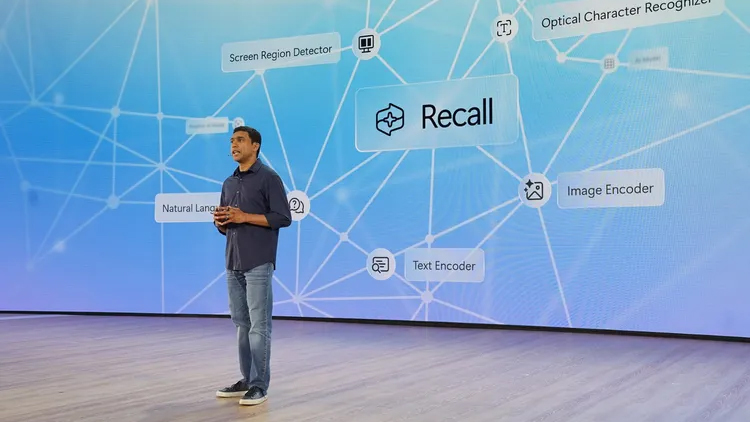Windows 11's new 'AI' Recall feature has been cracked to work without a fancy new NPU
If seven TOPs of AI power are enough for Recall, what's the point of an NPU?

Microsoft's newest AI tool, Recall, has been hitting the headlines that the Redmond software giant perhaps hasn't quite intended. Part of a collection of features that only Copilot+ PCs sport, Recall also demands that the processor running the software has an NPU. However, one ingenious coder has already got it to work perfectly well on a basic PC that doesn't have an NPU whatsoever.
I was able to get Recall working on this bad boy 😎Snapdragon 7c+ Gen3, 3.4 GB of RAM, no NPU in sightWill cook up a tutorial soon, it's surprisingly good even on something this low spec 😊 If you have any questions I'll do my best to answer them ✍️ pic.twitter.com/zzswm44Hy1May 25, 2024
The NPU, or neural processing unit, is the latest hardware bandwagon, with AMD, Intel, and Qualcomm all fighting to take ownership of the reins. Core Ultra, Ryzen 8040, and Snapdragon X processors all play host to a system of circuits that can handle the common operations used in AI routines.
One such application is Microsoft's Recall feature in Copilot+ and it needs an NPU capable of 45 TOPs (trillions of operations per second).
At the moment, the only chip with that level of NPU is Qualcomm's Snapdragon X series, but it turns out that Recall doesn't need that kind of performance at all. In fact, it doesn't even need an NPU. As reported by Neowin, X-user Albacore claims to have ported the application to run on a PC with just 4GB of RAM and a Snapdragon 7c+ Gen 3 processor.
Sure, it has a 'Qualcomm AI engine' but it's certainly not an NPU, and only boasts a peak performance of 6.5 TOPs—far lower than the 45 TOPs Microsoft claims are required for Copilot+.
At the moment, Albacore hasn't detailed exactly how this was achieved but does state that they plan to provide a tutorial on how to do it yourself in the future. One thing that's worth noting is that Copilot+ only works on Arm-based processors at the moment, so x86 owners will have to wait for a while or do some serious coding magic themselves.
Recall, like all of Microsoft's AI tools, relies on the DirectML API to act as the software bridge between the application and hardware drivers, just like games use Direct3D or Vulkan to get GPUs to draw pretty graphics. So, with the right know-how, it should be possible to get any reasonable hardware to handle Recall's instructions.
The biggest gaming news, reviews and hardware deals
Keep up to date with the most important stories and the best deals, as picked by the PC Gamer team.
With sales of PCs only just beginning to climb from a years-long slump and Windows 11 still being shunned by the overall computer market, Microsoft and hardware vendors have been searching for ways to reignite the world of PCs and get folks to buy new systems.

Best gaming PC: The top pre-built machines.
Best gaming laptop: Great devices for mobile gaming.
AI and NPUs have been part of that plan, but as this nifty little porting project shows, there's not really anything wrong with the hardware we've already got.
After all, there's nothing an NPU can do that a GPU can't, although they do have the advantage of being tiny in size and need very little power to work. Nvidia is certainly no fan of the current crop of NPUs and if the rumours of it entering the PC market are true, its hardware certainly won't be sporting an NPU.
The whole neural processing unit thing could then end up just fading away, once folks realise that an ordinary GPU can do all the AI stuff. If that happens, Microsoft will need to find another way of getting everyone to buy Windows 11.

Nick, gaming, and computers all first met in 1981, with the love affair starting on a Sinclair ZX81 in kit form and a book on ZX Basic. He ended up becoming a physics and IT teacher, but by the late 1990s decided it was time to cut his teeth writing for a long defunct UK tech site. He went on to do the same at Madonion, helping to write the help files for 3DMark and PCMark. After a short stint working at Beyond3D.com, Nick joined Futuremark (MadOnion rebranded) full-time, as editor-in-chief for its gaming and hardware section, YouGamers. After the site shutdown, he became an engineering and computing lecturer for many years, but missed the writing bug. Cue four years at TechSpot.com and over 100 long articles on anything and everything. He freely admits to being far too obsessed with GPUs and open world grindy RPGs, but who isn't these days?

